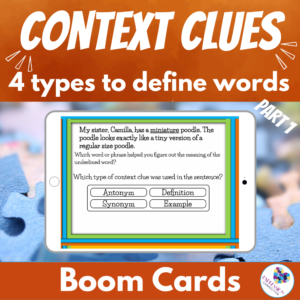Have you had students throw their hands in the air, giving up on reading assignments because they come across unfamiliar words, making it hard to understand what the author is trying to say? Coming across unfamiliar words in a text is inevitable. When this happens, context clues can help save the day. Context clues are hints that some authors include in their writing to help readers figure out the meaning of unknown words. When readers are able to understand the vocabulary, they can capture the meaning of the passage, easing frustration and making reading more pleasurable.
Four Types of Context Clues
- Defining a Word
- Synonym
- Antonym
- Example
Defining A Word
This type of context clue explains the meaning of a word by giving the word’s definition.
An example of this is:
In class, Karly is good at naming antonyms. Thinking of words that mean something completely different from another word comes easy to her.
The second sentence defines the word “antonym.”
Synonym
This type of context clue gives a similar word or a synonym to define a term.
For example:
Abby cautiously stepped onto the wet sidewalk, careful not to fall.
Careful is a synonym for the word “cautious.”
Antonym
This type of context clue uses an opposite word to help students figure out a word’s meaning.
An example of this type of clue is:
Jacob is seldom late for school. He usually gets to school early.
Usually is an antonym for the word “seldom.”
Example
This type of context clue provides an example to help students determine what a word means.
For example:
The old man is very feeble. He won’t be able to carry the boxes by himself.
The second sentence gives you an indication that “feeble” means weak.
Check out this Boom™Cards deck that gives your students practice identifying the four types of context clues









